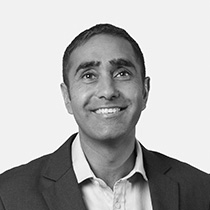The fund appreciated 4.7% in the first quarter of 2020, compared with the benchmark’s negative 6.0% return, resulting in 10.6% alpha for the period. During a very volatile period with extreme downward moves, it was pleasing to both generate alpha and a positive absolute return.
With the fund being a fully flexible fund, it was encouraging to see asset allocation was a large contributor towards the quarter’s performance. A collection of index put options was the largest contributor (4.4% positive impact), as various global indices turned heavily negative, and these options provided valuable protection. This was followed by a US dollar cash position (+28%, 1.5% positive impact), with the final noteworthy positive contributor being a gold bullion holding (+33%, 0.8% positive impact). Unfortunately, the fund still incurred losses on a few individual positions, with the largest being Unibail-Rodamco-Westfield (-51%, 1.4% negative impact), followed by Airbus (-44%, 1.1% negative impact) and Capri Holdings (-61%, 1.0% negative impact)
Over the past five years, the fund has generated a positive return of 10.7% p.a., 14.7% p.a. over 10 years and 14.3% p.a. (3.4% annualised outperformance) since inception over 20 years ago*.
The fund ended the quarter with 73% net equity exposure, slightly more than at the end of December. However, it should be noted that, during the quarter, net equity exposure was as low as 59%, with this having increased towards the end of the quarter as the fund started buying equities post the sell-off. Of this, approximately 54% of the equity exposure was invested in developed market equities and 46% in emerging market equities.
Our negative view on global bonds remained unchanged, as a large portion of developed market sovereign bonds offer negative yields to maturity, with the follow-on effect that most corporate bonds also offer yields which do not compensate you for the risk undertaken. Only 1.3% of the fund is invested in bonds, which is largely made up of a 0.7% position in L Brands (owner of Victoria’s Secret) corporate bonds.
The fund also has c. 4.5% invested in global property, largely Unibail (European and US retail property) and Vonovia (German residential property). Lastly, the fund has a physical gold position of 2.7%, along with a 1.5% holding in Barrick Gold Corp., the largest gold miner globally. The balance of the fund is invested in cash, largely offshore. As has been the case for many years, the bulk of the fund (over 90%) is invested offshore, with very little exposure to South Africa, barring some small new buys made during the quarter which collectively amount to just over 3% of the fund.
The disappointing performance of Unibail was driven by government-imposed lockdowns across Europe, forcing many of their tenants to close, with many now either refusing to pay rent or requesting some form of relief. We acknowledge that some sort of relief will most likely be granted, which will negatively impact cashflow in the short term; however, we are encouraged by Unibail proactively enhancing their liquidity position while cancelling the second half of their previously announced dividend. This provides them with enough liquidity to ensure they can meet all their obligations, even in a severely stressed scenario. The extreme downward share move (down c. 60% in euros since January 2020) is unwarranted in our view – the business now trades at levels last seen over 20 years ago, reflecting a 75% discount to net asset value. Notwithstanding the very real pressures on retail property during this crisis, we feel Unibail will survive the crisis and ultimately, the share will begin to trade at a price more reflective of its underlying fundamentals.
Notable buys during the quarter were Phillip Morris International (PMI), Barrick Gold Corp. and EssilorLuxottica.
PMI was an existing holding in the fund, which was increased materially (247 basis points bought) over the quarter as the stock fell 30% (in US dollars) from its peak in the Covid-19-induced panic. As the business is exposed to a consumption habit which is addictive and has largely been defensive in weak economic environments, we felt that the fall, which was in excess of the total market, was not warranted, as we feel there is little fundamental long-term impact to the business. It currently trades on c. 13 times forward earnings with a 7% dividend yield, which we view as highly attractive.
Barrick Gold Corp. is the product of a merger between legacy miner Barrick and Randgold, with Mark Bristow, the former Randgold CEO, taking the helm of the combined entity. This is notable, as Mark Bristow brings with him both a track record of exceptional operational execution and good capital allocation - a skill very hard to find in the gold mining industry. We expect Mark to apply his expertise to the legacy Barrick assets, which should generate a significant amount of value in the long term.
EssilorLuxottica is the global leader in design, manufacture and distribution of ophthalmic lenses, frames and sunglasses. The merger of Essilor and Luxottica created a vertically-integrated player with extensive distribution and global retail reach. The segments which drive their long-term business, being corrective eyewear and sun protection eyewear, have large structural tailwinds due to increasing penetration of their products, along with a growing addressable market due to increasing incidences of myopes (near-sightedness) and presbyopes (age-related far-sightedness). The share fell 30% (in euro), allowing the fund to purchase a stake in a high-quality business at a reasonable price. The business should be able to consistently grow earnings at mid- to high single-digits over the foreseeable future as its end-market expands, it realises synergies from the merger and leverages the significant Luxottica global retail footprint to sell Essilor lenses.
The future is always inherently difficult to predict, and this has been further compounded by Covid-19. However, we feel the fund has been constructed in a manner to ensure the highest risk-adjusted returns are achieved, while considering a very uncertain backdrop. As always, our greatest focus is delivering to our client expectations, and during this current crisis, this focus is as strong as ever.
* Launch date: 15 March 1999
Highest annual return 51.1% Jan 2013 - Dec 2013; Lowest annual return (31.5%) Mar 2008 - Feb 2009
 South Africa - Personal
South Africa - Personal




